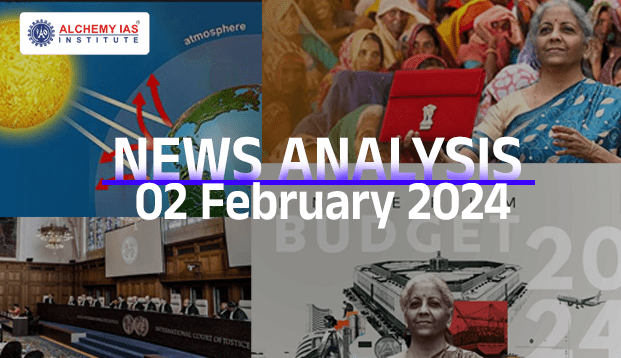2nd February, 2024 (Friday)

HEAT WAVE
Syllabus: GS. 1: Geography – Climatology
Why in News: Recently, the World Meteorological Organisation declared 2023 as the hottest year on record, emphasizing the urgency of understanding and addressing the effects of rising temperatures.
About Heat Wave
- What is heat wave?
- A Heat Wave is a period of abnormally high temperatures surpassing normal maximums during the summer season, typically from March to June, occasionally extending into July. Such extreme conditions induce physiological stress, often leading to fatalities.
- The criteria for declaring a heat wave are as follows:
- The Indian Meteorological Department (IMD) sets criteria for Heat Waves based on temperature thresholds:
- Heat waves are considered when the maximum temperature reaches at least 40°C for Plains and 30°C for Hilly regions.
- Departures from normal determine severity, with Severe Heat Waves declared at 7°C or more above normal for temperatures up to 40°C, and at 6°C or more for temperatures exceeding 40°C.
- When the maximum temperature remains at 45°C or higher, regardless of normal temperatures, heat waves are declared.
- The Indian Meteorological Department (IMD) sets criteria for Heat Waves based on temperature thresholds:
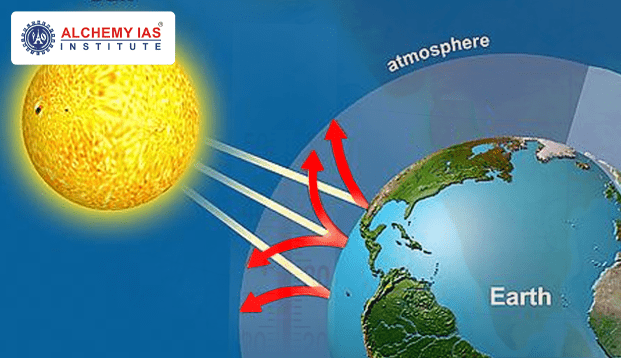
| Criterion | Heat Wave | Severe Heat Wave |
| Based on Departure from Normal | Departure from normal is 4.5°C to 6.4°C | Departure from normal is >6.4°C |
| Based on Actual Maximum Temp. | When actual maximum temperature ≥ 45°C | When actual maximum temperature ≥ 47°C |
- What is a criterion for describing Heat Wave for coastal stations?
- For coastal stations, a heat wave may be described when the maximum temperature departure is 4.5°C or more from normal, provided the actual maximum temperature is 37°C or more.
- Favorable conditions for heat waves include:
- Presence of hot dry air over a region, with a suitable flow pattern for transporting hot air.
- Limited moisture in the upper atmosphere, as moisture hampers temperature rise.
- Clear skies to maximize insulation over the region.
- Strong anti-cyclonic flow in the area.
Heat waves typically form over Northwest India and spread eastwards and southwards due to prevailing winds. However, under favorable conditions, heat waves may develop locally in any region.
- What is warm night?
- A “warm night” is considered when the maximum temperature remains at 40°C or more, and it is defined based on departures or actual minimum temperatures as follows:
- Warm night: minimum temperature departure is 4.5°C to 6.4°C
- Very warm night: minimum temperature departure is >6.4°C
- A “warm night” is considered when the maximum temperature remains at 40°C or more, and it is defined based on departures or actual minimum temperatures as follows:
- Health Impacts of Heat Waves
- Heat waves commonly lead to dehydration, heat cramps, exhaustion, and heat stroke. Symptoms include swelling and fainting for heat cramps, fatigue, weakness, dizziness, and nausea for heat exhaustion, and body temperatures of 40°C (104°F) or higher, accompanied by delirium or seizures, for heat stroke—a potentially fatal condition.
Globally, climate change is intensifying heat waves, with India experiencing increasingly severe instances annually, posing significant risks to human health.
| News Plus What is Heat Index? The Heat Index has been launched on an experimental basis by the India Meteorological Department (IMD).It aims to provide general guidance for regions experiencing higher apparent temperatures causing discomfort to people.The heat index is the combination of air temperature and relative humidity, it measure of how hot it really feels when relative humidity is factored in with the actual air temperature. |
‘LAKHPATI DIDI’ SCHEME
Syllabus: GS. 2: Social Justice – Schemes Mentioned in News
Why in News: In her Interim Budget 2024–25 speeches, Union Finance Minister Nirmala Sitharaman expanded the Lakhpati Didi Scheme, aligning with Prime Minister Narendra Modi’s goal of creating two crore women entrepreneurs in villages.
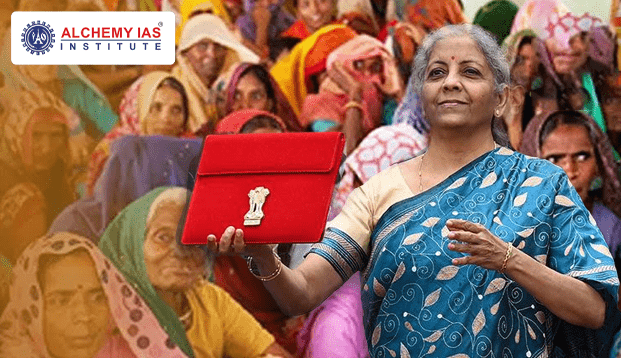
What is ‘Lakhpati Didi’ initiative?
- In August 2023, Prime Minister Narendra Modi unveiled the ‘Lakhpati Didi’ scheme aiming to create two crore empowered women entrepreneurs in villages, emphasizing the role of Women’s Self-Help Groups (SHGs).
- President Droupadi Murmu later underscored the significance of self-help groups in empowering marginalized communities, especially women, towards self-reliance by India’s centenary of independence.
- In her 2024-25 interim budget speech, Finance Minister Nirmala Sitharaman lauded the transformative impact of 83 lakh SHGs, revealing that nearly one crore women have already become ‘Lakhpati Didis.’ Consequently, the scheme’s target has been raised from two crore to three crore.
- Objectives
- The Lakhpati Didi scheme aims to empower women in rural areas by encouraging them to start micro-enterprises and providing training in various skills such as plumbing, LED bulb making, drone operation and repair, tailoring, and weaving, which would enable them to earn a sustainable income of at least ₹1 lakh per annum.
- Who is eligible?
- As the scheme is primarily aimed at women, participants in the Lakhpati Didi Scheme must be active members of self-help groups.
INTERNATIONAL COURT OF JUSTICE (ICJ)
Syllabus: GS. 2: IR – International Organisations in News
Why in News: The International Court of Justice (ICJ) ordered Israel to take measures to prevent acts of genocide in Gaza, but stopped short of calling for an immediate ceasefire as requested by South Africa.
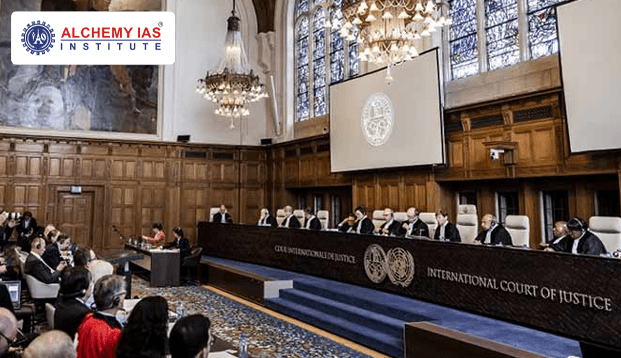
About the International Court of Justice (ICJ)
- The International Court of Justice (ICJ) is the principal judicial organ of the United Nations (UN).
- It was established in June 1945 by the Charter of the United Nations and began work in April 1946.
- The seat of the Court is at the Peace Palace in The Hague (Netherlands).
- Of the six principal organs of the United Nations, it is the only one not located in New York (United States of America).
- The Court is composed of 15 judges, who are elected for terms of office of nine years by the United Nations General Assembly and the Security Council. It is assisted by a Registry, its administrative organ. Its official languages are English and French.
- The Court’s role is to settle, in accordance with international law, legal disputes submitted to it by States and to give advisory opinions on legal questions referred to it by authorized United Nations organs and specialized agencies.
- It is not a criminal court, and it does not try individuals. That is the role of the International Criminal Court (ICC).
What is South Africa’s case against Israel?
- The ICJ cannot automatically decide all cases involving breaches of international law. It can only decide cases that are brought before it by States that consent to its jurisdiction.
- This consent can be expressed in different ways. In this case, the consent stems from an article in the Genocide Convention that states that disputes between parties relating to the interpretation, application, or fulfillment of the Convention, including disputes relating to the responsibility of a State for genocide, shall be submitted to the ICJ at the request of any of the parties to the dispute.
- Both South Africa and Israel are parties to the Convention.
- South Africa accuses Israel of committing acts that qualify as genocide, citing evidence of Israeli state officials’ specific intent to engage in genocidal acts or to neglect preventing them since October 2023.
- South Africa contends that immediate action is needed to prevent further harm to the rights of Palestinians, halt ongoing violations, and prevent escalation or expansion of the conflict.
- Israel has called the case “baseless” and a “blood libel”, and called on the international community to reject it. The United States, Hungary, and Guatemala have done so.
- Palestine, along with 57 Organisation of Islamic Cooperation (OIC) countries, Malaysia, Turkey, Jordan, Bolivia, Venezuela, Mexico, Bangladesh, Namibia, Nicaragua, and others, supports South Africa’s case.
- France will back the court’s decision, while India has not commented.
- This is not the first case the court will hear under the Genocide Convention. In 2022, Ukraine filed a case against Russia, and in 2019, the Gambia filed a case against Myanmar with respect to the Rohingya.
What is the Genocide Convention?
- The Genocide Convention, established by the United Nations in 1948, aims to prevent and punish genocide.
- Genocide is defined as specific acts with the intent to destroy, in whole or in part, a national, ethnic, racial, or religious group.
- These acts include killing, causing serious harm, imposing conditions leading to physical destruction, preventing births, and transferring children.
- The Convention requires both the acts and the intent to be present, distinguishing genocide from other crimes like war crimes and ethnic cleansing.
- Notably, only genocide grants automatic jurisdiction to the International Court of Justice.
| News Plus: About the International Criminal Court (ICC) The International Criminal Court (ICC), established by the Rome Statute, is the first permanent international criminal court. It investigates and prosecutes individuals accused of genocide, war crimes, crimes against humanity, and the crime of aggression. The ICC aims to hold perpetrators accountable and prevent future atrocities. Notably, India, along with the US and China, has not ratified the Rome Statute and thus is not a party to the ICC.Top of Form |
HIGHLIGHTS OF INTERIM BUDGET, 2024
Syllabus: GS.3: Indian Economy – Public Finance – Union Budget
Why in News: Union Finance Minister, Nirmala Sitharaman, presented the Interim Budget 2024. The Interim Budget for the fiscal year 2024-25 presents several key highlights across various sectors, aiming to bolster economic growth, infrastructure development, green energy initiatives, agricultural advancement, and research and development.
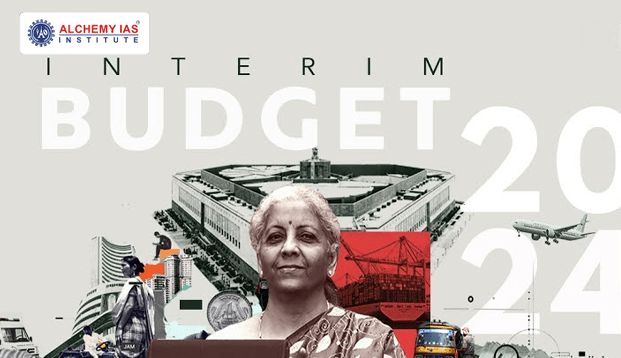
Highlights of Interim Budget, 2024:
| Category | Highlights | |
| Macro-economic Highlights | Budget Estimates | Total receipts other than borrowings are estimated at 30.80 lakh crore, with tax receipts projected at 26.02 lakh crore and total expenditure at 47.66 lakh crore. |
| Fiscal Deficit | Estimated fiscal deficit for 2024-25 is set to be 5.1% of GDP, with a revised fiscal deficit of 5.8% for the previous fiscal year, aligning with the target of reducing the deficit below 4.5% by 2025-26. | |
| Lower Borrowings | Central Government anticipates lower borrowings in 2024-25 compared to the previous year, facilitating increased availability of credit for the private sector. | |
| Direct & Indirect Tax | No changes in income tax slabs; tax exemptions for startups extended until March 31, 2025. Government withdraws outstanding direct tax demands up to certain amounts for specific financial years. The number of tax filers has significantly increased, and direct tax collection has tripled since 2014. | |
| Continuation of Interest-Free Loans | Scheme providing fifty-year interest-free loans for capital expenditure to states continues, with a total outlay of 1.3 lakh crore. | |
| Infrastructure Highlights | Capital Expenditure | Outlay for infrastructure capital expenditure increased by 11.1% for 2024-25, totaling eleven lakh, eleven thousand, one hundred and eleven crore rupees, equivalent to 3.4% of GDP. |
| Railway Corridor Programs | Various economic railway corridor programs announced to decongest high-traffic corridors and enhance passenger train operations. | |
| Expansion of PMAY-G | Two crore additional houses to be built under Pradhan Mantri Awas Yojana-Gramin. | |
| Rooftop Solarization (PM Suryoday Yojana 2024) | One crore households enabled to receive up to 300 units of free electricity per month through rooftop solarization. | |
| Green Energy Highlights | Offshore Wind Energy | Viability gap funding to support harnessing offshore wind energy potential. |
| Coal Gasification and Liquefaction | Plans include setting up coal gasification and liquefaction capacity to reduce natural gas, methanol, and ammonia imports. | |
| Mandatory CBG Blending | Phased mandatory blending of compressed biogas (CBG) in CNG and PNG for transport and domestic purposes to be implemented. | |
| Bio-Manufacturing and Bio-Foundry | New scheme to promote environment-friendly alternatives such as biodegradable polymers and bio-agri-inputs. | |
| Agriculture Highlights | Investment in Post-Harvest Activities | Promotion of investment in post-harvest activities and modernization of supply chains. |
| Nano DAP | Expansion of Nano DAP (Di-Ammonium Phosphate) application across various crops. | |
| Atmanirbhar Oil Seeds Abhiyan | Strategy to achieve self-reliance in oil seeds production. | |
| Dairy Development | Comprehensive support for dairy farmers and infrastructure development. | |
| Matsya Sampada | Scaling up of Pradhan Mantri Matsya Sampada Yojana to enhance aquaculture productivity and generate employment opportunities. | |
| Research and Development | Allocation of Rs. 1 lakh crore | – Allocation of Rs. 1 lakh crore to encourage private sector investment in research and innovation in sunrise domains. |
Overall, the Interim Budget focuses on enhancing economic growth, promoting sustainable development, and fostering innovation across various sectors to drive India’s progress.
DEFENCE ACQUISITION COUNCIL (DAC)
Syllabus: GS. 3: Defence Sector – Important Bodies in News
Why in News: The U.S. Congress was on February 1 formally notified of the possible sale of 31 MQ-9B high altitudes long endurance armed Unmanned Aerial Vehicles (UAV) to India estimated to cost $3.99 billion. The Defence Acquisition Council (DAC) had accorded the Acceptance of Necessity (AoN) for the procurement of 31 MQ-9B UAVs.
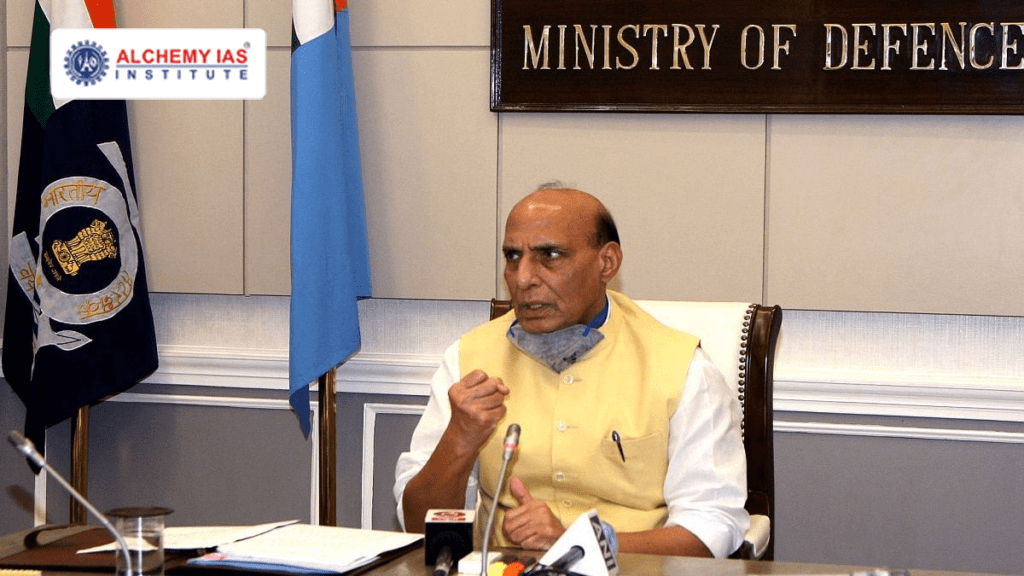
About the Defence Acquisition Council (DAC)
- The Defence Acquisition Council (DAC) stands as a pivotal entity within India’s defense framework, wielding significant influence in procurement decisions.
- Its inception traces back to the aftermath of the Kargil War in 1999, a conflict that unveiled critical shortcomings in India’s national security apparatus.
- To address these deficiencies, the Group of Ministers, in 2001, meticulously outlined recommendations aimed at fortifying the nation’s security infrastructure.
- Among these recommendations was the establishment of the DAC, conceived as the apex body entrusted with steering procurement initiatives within the Ministry of Defence.
- Composition of the DAC:
- The Defence Minister serves as the chairperson, providing political oversight.
- Key members include the Chief of Defence Staff (CDS) and the chiefs of the Army, Navy, and Air Force.
- This composition ensures comprehensive representation and synergy among different branches of the armed forces.
- Procedure of Defence Procurement
- DAC initiates the procurement process by according acceptance of necessity (AoN) to acquisition proposals and categorizes them into ‘Buy’, ‘Buy & Make’, and ‘Make’.
- The DAC also handles single vendor clearances, decisions on offset provisions for acquisitions exceeding Rs 300 crore, and Transfer of Technology under the ‘Buy & Make’ category.
- The Defence Procurement Policy (DPP) 2016, effective from April 1, 2016, aims to streamline procedures to boost indigenous defence production through initiatives like simplifying the ‘Make’ procedure and introducing the ‘Buy (Indian-IDDM)’ category.
- DAC’s clearance is crucial in this process, with the AoN being the first step.
| News Plus: What is Acceptance of Necessity (AoN):The approval, termed AoN, is the first step toward procurement of any military equipment and hardware under India’s defence acquisition norm. The tendering and contracting process is undertaken only after the grant of AoN. |

